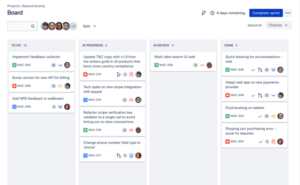Here’s an overview and examples of how IIoT can pay off in the business sector.

The internet of things has caused tremendous changes in homes and industries worldwide. Thanks to smart speakers, people can utter commands and do everything from tracking packages to finding recipes.
SEE: Hiring Kit: IoT developer (TechRepublic Premium)
Many consumers also have IoT devices that control their homes, such as setting the thermostat to save electricity or turning on the lights just before someone arrives home from work. Many business owners have also explored how industrial IoT could help their companies succeed. Here’s an overview and examples of how the technology can pay off in practice.
What is IIoT?
IIoT focuses on helping people use connected devices in their industries and workplaces. That might mean deploying smart sensors to measure water or pesticide usage on a farm, putting connected sensors on a critical piece of equipment or using these technologies to facilitate remote monitoring.
Generally, IIoT supports deployment on a massive scale, while consumer-based IoT products are primarily used in households. Thus IIoT also enables large data transfers across corporate networks.
Even the most well-equipped smart home probably has a few dozen sensors. However, a large company that has invested heavily in IIoT could have hundreds or thousands of sensors, all working together to provide valuable data for decision-makers.
What are the advantages of IIoT?
Most company leaders discover that thoughtfully deploying IIoT could help them save time and money while becoming more competitive. However, certain sectors are exceptionally well-positioned to notice gains after using IIoT. Healthcare is one of them. Here are some specific applications that can help you feel inspired.
Improved asset tracking
Hospitals have expensive but necessary equipment. If people don’t know where certain machines or products are at any time, the associated delays could cause preventable life-or-death situations. Even in less severe circumstances, failing to stay on top of asset tracking could lead to frustrating slowdowns that prolong patient wait times.
Many hospitals now use connected technologies that provide real-time updates as supplies are used or equipment moves from one area of the facility to another. Having such visibility also allows hospital administrators to see asset usage trends. For example, if a specific machine in the radiology department sees near-constant use, does that justify investing in another one as soon as financially feasible?
Better patient monitoring
Using IIoT to stay abreast of patient changes is another worthwhile option. It was widely used during the COVID-19 pandemic, especially when people needed to limit physical contact with infectious individuals. Moreover, when the health crisis put intensive-care beds in short supply, letting patients recover elsewhere while being monitored became viable.
In one instance, researchers deployed such a solution in a Brazilian hospital. Their technology collected 22 types of data from each patient and sent updates every five minutes. The deployment brought numerous gains to the ICU department. For example, a single physician could monitor all patients from anywhere. Data collection was also easier, while this approach reduced direct contact.
Enhanced resource usage
Many organizations invest in IIoT when decision-makers realize they must make major changes to stay up to date in relation to peers. That was the case in the oil and gas industry. One study found that 68% of executives at natural resources companies had created digital transformation strategies or were currently doing so.
IIoT is instrumental in helping hospital administrators use their resources effectively. Organizations that can’t do that risk operating at a loss or eventually closing their doors. For example, it can reduce admitted patients’ average length of stay.
Hospitals play a vital role in giving people specialized care when they need it. However, patients who stay in the hospital unnecessarily are at a higher risk of hospital-acquired infections and depleting valuable medical center resources. IIoT can give data about nearly every part of someone’s stay. That makes it easier for decision-makers to identify inefficiencies sooner rather than later.
Faster patient diagnostics
Certain patient complaints require immediate assessment. That’s one of the reasons why people complaining of chest pain are seen immediately when presenting at emergency departments. IIoT can assist with more efficient triage.
In one case, researchers adopted an IoT button originally developed by Amazon Web Services to quickly page a phlebotomist to perform a blood draw on someone experiencing chest pain. Doctors diagnose heart attacks by assessing the amount of troponin in the blood, which indicates heart damage.
This approach shortened the diagnostic time by an average of 11 minutes. The blood draw happened about seven minutes faster after the person entered the emergency room, representing the biggest gain. However, the time between placing the order and performing it also went down by two-and-a-half minutes. Similarly, there was an average two-minute reduction in drawing the blood and sending it to the lab.
These small efficiency improvements add up, especially when they concern people dealing with life-threatening conditions. When a patient is ill, it can seem like they go through a long process of lab tests and examinations before physicians reach their conclusions. However, using IIoT like this can eliminate unnecessary slowdowns by coordinating interactions between departments.
How will you use IIoT?
You’ve just learned about some of the many advantages of IIoT that are relevant to your work. However, there are other opportunities to deploy the technology. The best thing to do is think about the weaknesses within your organization and how the IIoT could improve things.
If you’re working toward implementing IIoT within your enterprise, selecting IIoT software is critical. There are hundreds of IIoT platforms and each one is slightly different from the next, so how do you choose? This article — including links to TechRepublic Premium resources — can help.
Source of Article


